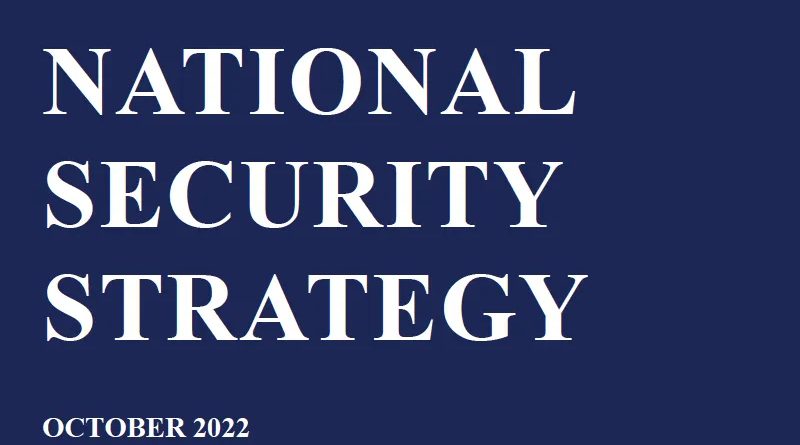What is the Strategy in the National Security Strategy?
By Daniel W. Drezner, Professor of International Politics at the Fletcher School of Law and Diplomacy at Tufts University
Full disclosure: if you’re researching, writing, or studying the global political economy, this month has been like ten tsunamis all hitting at the same time. Henry Farrell’s recent Twitter thread identifies some of these stories: the surge in weaponized interdependence, the U.S.-led effort to create a price cap on Russian oil, the recent U.S. moves restricting tech exports to China, EU leaders sounding more Hobbesian than Kantian, U.S. trade representatives sounding more like Friedrich List than Adam Smith, and so forth. Farrell didn’t even mention Liz Truss wreaking havoc on the British economy or the Federal Reserve roiling the global economy.
It’s been a month, is what I’m saying here.
With all of that, last week Biden finally released his National Security Strategy. The Biden team issued some (pretty good) interim strategic guidance soon after taking office. The NSS was supposed to be rolled out last winter but Jake Sullivan wisely decided that maybe that should be deferred until after Russia decided whether or not to invade Ukraine.
So the revised NSS came out last week, and I think the reaction was pretty much “meh.” Some observers were more supportive than others. The continuities with Trump’s national security strategy were noted. With the events of the past month,, one wonders if it might have already been overtaken by events.
Part of this is that no modern NSS is going to supplant, say, Kennan’s Long Telegram or even NSC-68 as a strategy document (also, never forget, the one that came the closest was Bush’s 2002 NSS and that ended… poorly). As Richard Fontaine, CEO for the Center for a New American Security, points out, the best one can hope for from an NSS is as a guide to what matters and what is to be done: “NSSs do more signaling than strategizing, and they resemble more than anything else really long speeches. They work most effectively as messages about priorities and intent, to the US government, Americans, and the world.”
Still, having read it, I’m not entirely sure that the 2022 NSS meets Fontaine’s bar.
The problem is not with the analysis of the current threat environment. Biden’s NSS appropriately sorts threats into two big baskets: revisionist, autocratic great powers and big transnational threats like climate change and/or pandemics. That sounds about right. It’s analysis of the different threat posed by Russia and China also seem spot on.
There are two big problems, however. The first is that although it halfheartedly tries to resist the dichotomy, the NSS eventually leans into the autocracy/democracy dichotomy: “we are trying to support every country, regardless of size or strength, in exercising the freedom to make choices that serve their interests. This is a critical difference between our vision, which aims to preserve the autonomy and rights of less powerful states, and that of our rivals, which does not.”
The trouble with this formulation is that there are an awful lot of autocracies out there, and I am curious exactly how the Biden administration is going to cope with all of them. Beyond China and Russia, there is Iran, North Korea, Afghanistan, Syria, Cuba, Nicaragua, and so forth. The Biden administration now wants to add Saudi Arabia and the United Arab Emirates to the list. What is the rank ordering here?
Credit where due, this NSS differs from Trump’s in embracing alliances and partnerships with European and Indo-Pacific allies. But there are some places in the world *COUGH* the Middle East *COUGH* where relying solely on democracies will not work. What then?
To put it bluntly: the United States seems to be racking up enemies at a pretty rapid rate. Maybe Washington can combat all of them at the same time, but it would probably be a good idea to prioritize among the bad guys.
The other problem is something I alluded to late last week. The Biden administration accuses its autocratic rivals of a lot of bad stuff: “it is their behavior that poses a challenge to international peace and stability—especially waging or preparing for wars of aggression, actively undermining the democratic political processes of other countries, leveraging technology and supply chains for coercion and repression, and exporting an illiberal model of international order.”
The United States does not do everything on that list — but it does some of those things! The Biden administration has been super-enthusiastic about “leveraging technology and supply chains for coercion.” Heck, throw in the dollar’s centrality and you have the Biden administration’s approach to economic statecraft. And it is understandable that U.S. allies might be a bit wary of the U.S. weaponizing some interdependence on them. The New York Times recently reported that, “President Biden’s efforts to bolster domestic manufacturing are coming under diplomatic fire from key allies, with European governments accusing his administration of undercutting the trans-Atlantic alliance with ‘Made in America’ policies that threaten their economies.”
This is not a new complaint of mine — it has always been a contradiction at the heart of the Biden administration’s approach to foreign economic policy. I’m just disappointed it wound up in the National Security Strategy as well.
This piece is republished from Drezner’s World.

